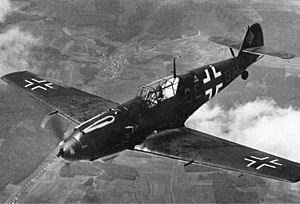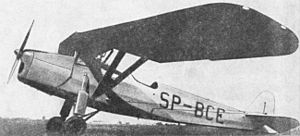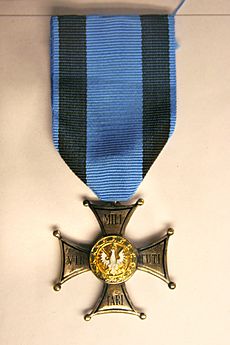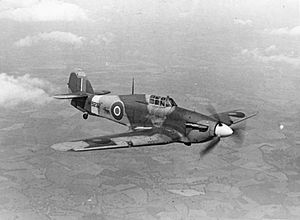Josef František facts for kids
Quick facts for kids
Josef František, DFM & Bar
|
|
|---|---|
 |
|
| Born | 7 October 1914 Otaslavice, Austria-Hungary (now Czech Republic) |
| Died | 8 October 1940 (aged 26) Ewell, Surrey, England |
| Buried | |
| Allegiance | Czechoslovakia Poland France United Kingdom |
| Service/ |
Czechoslovak Air Force Polish Air Force French Foreign Legion Armée de l'Air Royal Air Force |
| Years of service | 1934–1940 |
| Rank | Sergeant |
| Service number | 793451 |
| Unit | No. 303 Polish Fighter Squadron |
| Battles/wars | Second World War |
| Awards | Distinguished Flying Medal & Bar Croix de guerre Silver Cross of the Virtuti Militari Cross of Valour (3) |
Josef František (born October 7, 1914 – died October 8, 1940) was a brave Czechoslovak fighter pilot. He was an amazing pilot, known as a "flying ace," during World War II. He flew for the air forces of Czechoslovakia, Poland, France, and the United Kingdom.
František was the pilot who shot down the most enemy planes among all non-British Allied pilots during the Battle of Britain. He achieved 17 confirmed victories and one probable victory. All these wins happened in just four weeks in September 1940.
Even though he was a brilliant pilot, František often had trouble following rules. This happened in Czechoslovakia, France, and Britain. The British Royal Air Force (RAF) found it was best to let him fly alone. In this role, he was incredibly successful. Sadly, he died in a plane crash in October 1940, during the last week of the Battle of Britain.
Contents
Early Life in Czechoslovakia
Josef František was born in 1914 in Otaslavice, which was then part of Austria-Hungary (now the Czech Republic). His father was a carpenter. After finishing school, Josef started training to become a locksmith.
However, in 1934, he decided to join the Czechoslovak Air Force. He trained at the Air Training School in Prostějov. By 1935, he was a corporal in the 1st Air Regiment. In 1936, he finished his training. He was then sent to the 2nd Air Regiment in Olomouc, where he flew reconnaissance planes. These planes were used for looking at enemy positions. By 1937, he had become a sergeant.
František sometimes got into trouble for fighting or being late. He could have been removed from the air force. But he was such an exceptionally good pilot that they sent him to train as a fighter pilot instead. In June 1938, he became a fighter pilot. He flew Avia B-534 biplane fighters. This is where he really improved his flying and combat skills.
On March 15, 1939, Germany took control of the rest of Czechoslovakia. They made the country's army break up.
Joining the Polish Air Force
Many Czechoslovak airmen secretly escaped to Poland. František was one of them. He and three friends were smuggled across the border by train in June. They went to the Czechoslovak Consulate in Krakow and stayed in a special camp.
In July 1939, František and other Czechoslovak airmen were going to sail to France. But some Polish officials asked them to stay and join the Polish Air Force. Many Czechoslovaks decided to go to France. But František and his friends flipped a coin to decide. It landed "tails," so they stayed and joined the Polish Air Force.
František and his group learned to fly Polish planes at Dęblin airbase. František became an instructor. He flew older training planes like the RWD 8.
On September 1, 1939, Germany invaded Poland. The next day, German planes attacked Dęblin airbase. František's unit moved its planes to another location. During one patrol, a fellow pilot ran out of fuel and had to land near German lines. František landed nearby and rescued him.
František's unit kept moving away from the fighting. From September 7, he flew missions to scout for the enemy. He flew unarmed training planes with an observer. On September 19-20, he even attacked enemy groups by throwing hand grenades from his plane! On September 20, his plane was damaged by ground fire. He had to make an emergency landing. Two other pilots landed and rescued František and his observer.
For his brave service in Poland, František received the Virtuti Militari medal and the Cross of Valour four times.
On September 22, František's unit was told to go to Romania. They flew there and were held by the Romanian authorities. But many Polish airmen, including František, escaped. František and three other Czechoslovak airmen went to Constanța. From there, a ship took them to Beirut in French-controlled Lebanon.
Flying for France
In Beirut, staff from the Czechoslovak Embassy told them they had to join the French Foreign Legion or be sent back to German-controlled Czechoslovakia. The four airmen joined the Legion. A week later, they sailed to Marseille, France. They continued training at a Foreign Legion base. A Polish sergeant saw their Polish war medals and helped them join the new Free Polish Air Force in France.
Once in France, Czechoslovak airmen were being trained to fly French planes. František and two friends wanted to join other Czechoslovaks in the French Air Force. But a Czechoslovak officer accused them of leaving the Foreign Legion without permission. František then accused the Czechoslovak Air Force of not moving its planes to Poland when Germany invaded. The officer called the French police. But the police saw that František and his friends had proper Polish military ID. They refused to arrest them. So, František and his friends stayed with their Free Polish units.
František was sent to a Polish airbase in Clermont-Ferrand. He worked as a mechanic there. He tried to learn to fly as many types of French planes as he could. He also got into trouble several times for leaving without permission. There are no official French records to confirm he flew combat missions during the Battle of France. However, some older stories say he shot down 11 enemy planes. In his hometown, there is a museum with his medals, including a French Croix de Guerre.
Hero of the Royal Air Force
After France surrendered in June 1940, František escaped to Britain. After more training, he joined Polish No. 303 Squadron on August 2. This squadron was based at RAF Northolt and flew Hawker Hurricane fighter planes. František was used to older planes with fixed landing gear. On August 8, he forgot to lower his Hurricane's wheels and landed on its belly. He was not hurt, and the plane was fixed.
The squadron started fighting in the last part of the Battle of Britain. František's first confirmed victory was shooting down a German Messerschmitt Bf 109 fighter on September 2, 1940. His fifth victory almost cost him his life. On September 6, he shot down another Bf 109. But František's Hurricane was so badly damaged that he had to make an emergency landing.

František was a very independent pilot. His commanders thought he was a danger to others when flying in formation. His British commander offered to move him to a Czech squadron. But František chose to stay with his Polish friends. Since all pilots were important, they found a solution. František was given a "spare" plane. This way, he could fly as a "guest" of the squadron whenever he wanted.
So, František fought his own private war. He would fly with the squadron, then break off to patrol alone over Kent. He knew German planes would fly through this area on their way back to base. They might be damaged, low on fuel, or out of ammunition.
Between September 2 and 30, he shot down 17 German planes and probably one more. This included nine Bf 109 fighters, six Heinkel He 111 bombers, and one Junkers Ju 88 bomber. This made him one of the top Allied fighter pilots in the Battle of Britain. On September 20, King George VI gave him the Distinguished Flying Medal. Later, another award (a "bar") was added to his medal. His last confirmed victory was a Bf 109 on September 30, 1940.
On October 8, 1940, František's Hurricane crashed in Ewell, Surrey, after a patrol. The reason for the crash is not known. Some people think he might have been doing stunts to impress his girlfriend, who lived nearby. Others believe it might have been because he was very tired from fighting. František is buried in the military section of Northwood cemetery in England. He rests there with Polish and British RAF colleagues.
Legacy and Remembrance

František was the first non-British pilot to receive a "bar" added to his Distinguished Flying Medal. This was given to him after his death on October 28, 1940. In 1942, Air Vice-Marshal Karel Janoušek called František an "almost legendary figure." He also quoted a book that called František "the greatest of all Czechoslovak pilots, perhaps one of the greatest fighters of all time."
In his hometown of Otaslavice, there is a museum in his memory. There is also a monument outside his family home and a plaque at the local primary school. A street in Prague is named "Františkova" after him. The 100th anniversary of his birth was celebrated in Otaslavice on October 4, 2014. On October 6, 2015, the Polish Institute in Prague remembered the 75th anniversary of his death. People still place wreaths and flowers at the monument in Otaslavice every year on his birthday. On September 4, 2022, a new memorial was unveiled in Epsom, England, near where he died.
Honours and Awards
 Virtuti Militari Silver Cross (Poland)
Virtuti Militari Silver Cross (Poland) Cross of Valour 4 times (Poland)
Cross of Valour 4 times (Poland) Croix de guerre with palm leaf (France)
Croix de guerre with palm leaf (France) Distinguished Flying Medal and bar (United Kingdom) (awarded Oct. 1, 1940, and Oct. 28, 1940)
Distinguished Flying Medal and bar (United Kingdom) (awarded Oct. 1, 1940, and Oct. 28, 1940) 1939–1945 Star with Battle of Britain clasp
1939–1945 Star with Battle of Britain clasp Czechoslovak War Cross 1939–1945
Czechoslovak War Cross 1939–1945 Československá medaile Za chrabrost před nepřítelem ("Bravery in Face of the Enemy")
Československá medaile Za chrabrost před nepřítelem ("Bravery in Face of the Enemy") Československá medaile za zásluhy, 2. stupně ("Medal of Merit, Second Class")
Československá medaile za zásluhy, 2. stupně ("Medal of Merit, Second Class")
After his death, the president of the Czech Republic, Miloš Zeman, gave him the Order of the White Lion 1st Class Military Division on October 28, 2015. In 2017, the Czech Mint made special silver and gold coins to honor Josef František.
Images for kids





